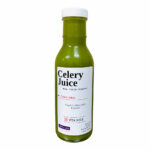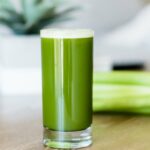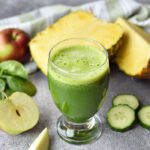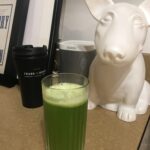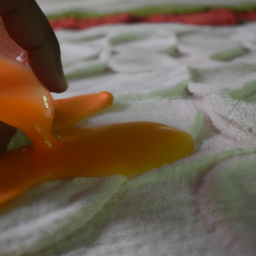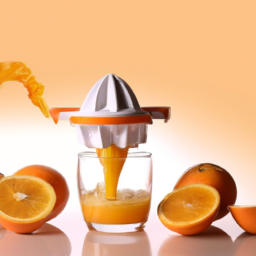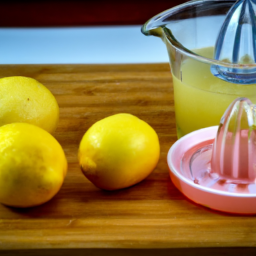I have struggled with high blood pressure for years, trying different medications and lifestyle changes to keep it under control. Recently, I found out about the benefits of celery juice for managing high blood pressure and decided to give it a try.
I was pleasantly surprised by the results, and now I want to share my experience and knowledge with others who may be struggling with this condition.
High blood pressure, also known as hypertension, is a common condition that affects millions of people worldwide. It occurs when the force of blood against the walls of your arteries is consistently too high, which can lead to serious health problems such as heart disease, stroke, and kidney failure.
While there are many medications available to manage high blood pressure, lifestyle changes such as diet and exercise can also be effective. In this article, I will be sharing how to make celery juice for high blood pressure, as well as other lifestyle changes that can help manage this condition.
Key Takeaways
- Celery contains unique compounds called phthalides that can help regulate blood pressure by relaxing the muscles in the walls of blood vessels.
- To make celery juice for high blood pressure, select firm, bright green stalks with leaves that are not wilted, rinse thoroughly, and cut into smaller pieces that will fit in a high-quality juicer.
- Experiment with flavor variations by adding lemon, ginger, or other fruits and vegetables to celery juice for additional health benefits such as boosting immunity and aiding digestion.
- Celery juice may interact with certain medications, so it’s important to speak with a healthcare provider before adding it to the diet.
Understanding High Blood Pressure
You may be wondering why high blood pressure is a concern and how it affects your body. High blood pressure, or hypertension, is a condition where the force of blood against the walls of your arteries is consistently too high. Over time, this can damage your arteries, leading to serious health problems such as heart disease, stroke, and kidney failure.
Unfortunately, hypertension often has no symptoms, which is why it’s sometimes called the ‘silent killer’. There are several causes of high blood pressure, including genetics, age, and lifestyle factors such as being overweight, not getting enough exercise, and eating a diet high in salt and processed foods.
Fortunately, there are also many lifestyle changes you can make to help manage your blood pressure. These include eating a healthy diet rich in fruits, vegetables, and whole grains, maintaining a healthy weight, staying physically active, reducing stress, and limiting alcohol and tobacco use. By making these changes, you can help lower your blood pressure and reduce your risk of developing serious health problems.
As we transition into discussing the benefits of celery juice for high blood pressure, it’s important to note that incorporating natural remedies into your lifestyle changes can also be helpful in managing hypertension.
The Benefits of Celery Juice for High Blood Pressure
I’m excited to dive into the benefits of celery juice for high blood pressure!
Did you know that celery is packed with important nutrients like vitamin K, vitamin C, and potassium?
But what really sets celery apart is its unique phthalides, which have been shown to help regulate blood pressure.
Let’s explore how this humble vegetable can help us achieve better heart health.
Nutritional Content of Celery
The nutritional content of celery is impressive, as it contains high amounts of vitamin K, vitamin C, and potassium, which have all been linked to lower blood pressure levels. The health benefits of consuming celery extend beyond blood pressure regulation, as it’s also a great source of fiber, antioxidants, and other essential vitamins and minerals.
Here are some nutritional facts about celery that you should know:
- One cup of chopped celery contains only 16 calories, making it a great low-calorie snack option.
- Celery is 95% water, which means it can help keep you hydrated throughout the day.
- The high fiber content in celery can help improve digestion and prevent constipation.
- Celery is also a good source of folate, which is essential for healthy fetal development during pregnancy.
All of these nutritional benefits make celery a great addition to any diet, especially for those looking to improve their blood pressure levels. But how exactly does celery help regulate blood pressure? Let’s explore the role of phthalides in the next section.
Phthalides and Blood Pressure Regulation
By consuming celery, you can benefit from its phthalides, which have been shown to aid in the regulation of cardiovascular health. Phthalides are compounds found in celery that relax the muscles in the walls of our blood vessels, allowing for increased blood flow and reduced blood pressure.
According to a study published in the Journal of Medicinal Food, participants who consumed celery extract experienced a significant decrease in both systolic and diastolic blood pressure levels. This is great news for those seeking natural remedies for hypertension.
Incorporating celery juice into your diet can provide you with these phthalides and their blood pressure regulating benefits. But before you start juicing, it’s important to select and prepare your celery correctly.
How to Select and Prepare Celery for Juicing
To ensure maximum health benefits, it’s important to carefully select and prepare your celery before juicing. When selecting celery, look for firm, bright green stalks with leaves that are not wilted. Avoid celery that appears yellow or brown, as it may be past its prime.
Organic celery is preferable, as conventionally grown celery may contain high levels of pesticides. Before juicing, rinse the celery thoroughly under cool running water and remove any dirt or debris. If desired, trim the root end and any brown or wilted portions of the stalks.
Cut the celery into smaller pieces that will fit easily into your juicer. By taking these steps to select and prepare your celery, you can ensure that your celery juice is not only delicious, but also highly nutritious. Now, let’s move on to how to make celery juice at home.
How to Make Celery Juice at Home
If you want to reap the full benefits of celery, it’s essential to know how to prepare and juice it properly.
Juicing celery is a straightforward process that requires a few simple steps. First, rinse the celery thoroughly to remove any dirt or debris. Then, cut the celery into smaller pieces that can fit into your juicer. For best results, use a high-quality juicer that can extract as much juice as possible.
When juicing celery, there are a few techniques you can use to enhance the flavor and texture. Some people prefer to juice celery with other fruits and vegetables, such as apples, cucumbers, or ginger. This can add extra nutrients and flavor to your juice. Others prefer to add a squeeze of lemon or lime to their celery juice to give it a tangy kick. Experiment with different flavor variations to find the one that works best for you.
To incorporate celery juice into your daily routine, there are many ways to enjoy it. You can drink it in the morning as a healthy start to your day or sip it throughout the day as a refreshing beverage. Some people prefer to mix their celery juice with other juices or smoothies to create a more complex flavor profile. Whatever your preference, drinking celery juice regularly can help lower your blood pressure and improve your overall health.
Incorporating Celery Juice into Your Daily Routine
Incorporating celery juice into your daily routine is like adding a burst of freshness and vitality to your day. I suggest starting with a morning routine where you drink a glass of celery juice before eating or drinking anything else. This helps your body absorb the nutrients more efficiently and jumpstarts your digestion for the day.
To keep things interesting, try experimenting with flavor variations. You can add a slice of lemon or ginger for a citrusy kick or a pinch of turmeric for its anti-inflammatory properties. You can also mix in other fruits and vegetables like apples, carrots, or cucumbers for added flavor and nutrition. With these simple additions, you can turn your plain celery juice into a delicious and healthy drink.
As you begin to incorporate celery juice into your daily routine, it’s important to keep in mind some tips and tricks for making the best celery juice.
Tips and Tricks for Making the Best Celery Juice
Hey, buddy! Want to know the secrets to whipping up the tastiest and healthiest celery juice ever? Look no further because I’ve got some tips and tricks for making the best celery juice. But before we get started, let’s talk about juicer maintenance. It’s essential to clean your juicer after each use to prevent bacteria buildup and ensure optimal performance. Refer to the manufacturer’s instructions for cleaning and maintenance tips.
Now, let’s dive into the fun part – celery juice variations. While plain celery juice is excellent for high blood pressure, you can spice things up by adding other ingredients like lemon, ginger, or cucumber. Not only do they add flavor, but they also bring additional health benefits. Check out the table below for some celery juice variations that you can try.
| Celery Juice Variation | Ingredients | Health Benefits |
|---|---|---|
| Celery-Lemon | Celery, Lemon | Boosts immunity, aids digestion |
| Celery-Ginger | Celery, Ginger | Reduces inflammation, improves circulation |
| Celery-Cucumber | Celery, Cucumber | Hydrates, promotes healthy skin |
Incorporate these variations into your daily routine to keep things exciting. And with a little juicer maintenance, you’ll be on your way to making the best celery juice ever. Now, let’s transition into the next section about other lifestyle changes for managing high blood pressure.
Other Lifestyle Changes for Managing High Blood Pressure
When it comes to managing high blood pressure, making lifestyle changes is crucial. I’ve found that incorporating regular exercise and physical activity into my routine has been helpful. Stress reduction and relaxation techniques, such as deep breathing and meditation, have also been effective in managing my blood pressure. These lifestyle changes may require some effort, but the benefits are worth it for a healthier life.
In addition to drinking celery juice, adjusting my diet has also been important. I’ve reduced my intake of sodium and processed foods, while increasing my consumption of fruits, vegetables, and whole grains. It’s important to work with a healthcare provider to develop a personalized plan for managing high blood pressure. With a combination of lifestyle changes and medication, it is possible to keep blood pressure under control and reduce the risk of complications.
Exercise and Physical Activity
You can easily improve your overall health by simply adding more physical activity to your daily routine, which will greatly benefit your high blood pressure. Whether it’s indoor or outdoor exercise, regular physical activity can help control your blood pressure.
Engaging in group fitness activities can also be a great way to stay motivated and accountable, while also providing an opportunity to socialize and make new friends.
In addition to its positive effects on blood pressure, exercise has numerous other benefits for your health. It can help you maintain a healthy weight, improve your mood, and reduce your risk of chronic diseases such as heart disease and diabetes.
So, make sure to prioritize physical activity in your daily routine to reap all of its health benefits.
Now, let’s explore some stress reduction and relaxation techniques.
Stress Reduction and Relaxation Techniques
To effectively manage stress levels and promote relaxation, it’s important to incorporate techniques such as mindfulness meditation and deep breathing exercises into your daily routine. These methods can have a profound impact on your overall well-being and health.
Mindfulness meditation involves focusing your attention on the present moment, accepting your thoughts and feelings without judgment, and allowing yourself to become more aware of your physical sensations. Deep breathing exercises, on the other hand, involve taking slow, deep breaths that fill your lungs and release tension from your body.
Here are four techniques to help you get started:
-
Mindful Breathing: Find a quiet place where you can sit comfortably. Close your eyes and focus your attention on your breath. As you inhale, feel your stomach expand, and as you exhale, feel your stomach contract. Continue to do this for several minutes, allowing your mind to become calm and focused.
-
Body Scan: Lay down on your back and close your eyes. Focus your attention on each part of your body, starting at your toes and moving up to the top of your head. As you focus on each part, tense and then relax the muscles. This exercise can help release tension from your body.
-
Gratitude Practice: Take a few minutes each day to reflect on what you’re grateful for. This can help shift your focus from negative thoughts to positive ones, and help you develop a more positive outlook on life.
-
Progressive Muscle Relaxation: This technique involves tensing and then relaxing your muscles. Start at your toes and work your way up to your head, tensing each muscle group for a few seconds before releasing the tension. This exercise can help reduce muscle tension and promote relaxation.
Incorporating these techniques into your daily routine can help reduce stress and promote relaxation. However, it’s important to remember that these techniques aren’t a substitute for professional medical advice. In the next section, we’ll discuss precautions and possible side effects to be aware of when managing high blood pressure.
Precautions and Possible Side Effects
Before trying any new treatment, it’s important to understand the potential risks involved. When it comes to celery juice for high blood pressure, there are a few precautions to keep in mind.
Firstly, celery juice may interact with certain medications, so it’s important to speak with a healthcare provider before adding it to your routine.
Additionally, some people may experience allergic reactions or digestive issues when consuming celery juice.
Interactions with Medications
Although celery juice is generally considered safe, it’s important to note that it can potentially interact with certain medications, such as blood thinners and diuretics. If you’re taking any prescription medication, it’s best to consult with your healthcare provider before adding celery juice to your diet.
Some of the medication reactions that may occur with celery juice include:
- Increased risk of bleeding: Celery juice contains compounds that may have blood-thinning effects, which could increase the risk of bleeding when taken with blood-thinning medications.
- Excessive diuresis: Celery juice is a natural diuretic, which means it can increase urine production and lead to a loss of fluids and electrolytes. This effect may be amplified when taken with diuretic medications, leading to dehydration and electrolyte imbalances.
- Decreased blood pressure: Celery juice may lower blood pressure, which can be beneficial for people with hypertension. However, taking it with medications that also lower blood pressure could lead to an excessive drop in blood pressure, causing dizziness, lightheadedness, or fainting.
It’s important to take these medication reactions and dosage concerns into account when incorporating celery juice into your diet for high blood pressure.
In the next section, I’ll discuss some of the possible allergic reactions and digestive issues that may arise from consuming celery juice.
Allergic Reactions and Digestive Issues
Allergic reactions and digestive issues can occur when consuming celery juice, so it’s important to be aware of the potential risks. Common triggers for allergic reactions include itching, hives, and swelling, while digestive issues can range from bloating to diarrhea. If you experience any of these symptoms after consuming celery juice, it’s important to stop drinking it and seek medical attention.
Management strategies for allergic reactions and digestive issues include avoiding celery juice altogether or slowly introducing it into your diet to assess your tolerance. Additionally, you can try cooking celery instead of consuming it raw, as this may reduce the likelihood of a reaction. It’s also important to read labels carefully and avoid products that contain celery if you have a known allergy.
It’s important to monitor your blood pressure regularly, especially if you have high blood pressure. By making celery juice a part of your daily routine, you can potentially lower your blood pressure and improve your overall health. However, it’s crucial to be aware of the potential risks and address any allergic reactions or digestive issues promptly.
Monitoring Your Blood Pressure
Keep an eye on your blood pressure readings regularly to take control of your health and prevent potential health risks. Blood pressure tracking is crucial to monitor the effectiveness of lifestyle modifications aimed at lowering high blood pressure.
You can easily track your blood pressure at home using a blood pressure monitor or by visiting your healthcare provider regularly. Lifestyle modifications such as maintaining a healthy diet, regular exercise, and stress management can significantly lower your blood pressure.
However, it’s essential to monitor your blood pressure regularly to ensure that these modifications are working for you. By tracking your blood pressure, you can identify any potential issues early on and take action to prevent further health risks.
Now that we’ve discussed the importance of monitoring your blood pressure, let’s move on to the final thoughts and resources section.
Final Thoughts and Resources
Don’t forget to check out the additional resources provided below to learn more about maintaining a healthy lifestyle and reducing the risk of cardiovascular disease. These resources can provide you with more information on managing high blood pressure, including tips on exercise, diet, and stress management.
It’s important to remember that managing high blood pressure is not just about taking medication, but also about making lifestyle changes. In my personal experience, making small changes to my daily routine, such as incorporating more physical activity and eating a balanced diet, has greatly improved my overall health and lowered my blood pressure.
Remember to always consult with your healthcare provider before making any significant changes to your lifestyle or starting a new exercise or diet plan. With the right support and resources, managing high blood pressure is possible and can greatly improve your quality of life.
Frequently Asked Questions
Can celery juice completely cure high blood pressure?
While celery juice has been shown to lower blood pressure, it is not a guaranteed cure. Incorporating celery juice into a balanced diet offers various benefits for overall health, but consuming too much can lead to potential side effects.
Is it necessary to use a juicer for making celery juice or can it be made with a blender?
I suggest using a juicer for celery juice, as it yields a smoother consistency and is more efficient. However, a blender can work if you strain the juice afterwards. Here are some celery juice recipes for high blood pressure.
Can celery juice interact with any medications used for treating high blood pressure?
Hey there! Did you know that celery juice can interact with certain medications used for treating high blood pressure? It’s important to always check with your doctor and follow their recommended dosage to avoid any potential drug interactions.
How long does it take for celery juice to start showing positive effects on high blood pressure?
Based on scientific evidence, celery juice can lower high blood pressure within a week. Beyond hypertension, it also offers benefits for digestion, skin, and inflammation. Incorporate it into your diet for overall health.
Are there any specific types of celery that are better for making juice for high blood pressure?
When it comes to lowering blood pressure, some celery varieties are better than others due to their higher nutritional benefits. However, there are also alternative options to celery that can aid in reducing hypertension.
Conclusion
So, there you have it – everything you need to know about making celery juice for high blood pressure. It’s a simple process that can have a profound impact on your health.
Celery juice is a natural way to lower blood pressure, thanks to its high potassium content and ability to reduce inflammation. Plus, it’s easy to incorporate into your daily routine and can be a refreshing addition to your diet.
As you start to make celery juice a regular part of your routine, it’s important to also make other lifestyle changes to manage high blood pressure. One interesting statistic to keep in mind is that nearly half of all adults in the United States have high blood pressure, according to the American Heart Association.
By making simple changes like juicing celery, eating a healthy diet, and exercising regularly, you can reduce your risk of developing this common condition and improve your overall health.
Remember to monitor your blood pressure regularly and work with your healthcare provider to develop a plan that’s right for you. And if you experience any side effects or have concerns about incorporating celery juice into your diet, be sure to speak with your doctor.
With the right information and a commitment to making healthy choices, you can take control of your health and enjoy a better quality of life.
Ilana has been a vegan for over 10 years. She originally made the switch for health reasons, but soon found herself becoming more and more passionate about the ethical and environmental implications of a vegan lifestyle. Ilana is the author of The Graceful Kitchen, a blog all about veganism. She loves to cook up delicious and nutritious vegan meals, and share her recipes with others who are interested in leading a cruelty-free life. Ilana is also a strong advocate for using whole foods as the foundation of a healthy diet, and believes that going vegan is one of the best ways to achieve this.



